
The Battle of the Thames, also known as the Battle of Moraviantown, was an American victory in the War of 1812 against Tecumseh's Confederacy and their British allies. It took place on October 5, 1813, in Upper Canada, near Chatham. The British lost control of Southwestern Ontario as a result of the battle; Tecumseh was killed, and his confederacy largely fell apart.

Prairie du Chien is a city in and the county seat of Crawford County, Wisconsin, United States. The population was 5,506 at the 2020 census. Often called Wisconsin's second-oldest city, Prairie du Chien was established as a European settlement by French voyageurs in the late 17th century. Its settlement date of June 17, 1673, makes it the fourth colonial settlement by European settlers in the Midwestern United States, after Green Bay, Wisconsin, Sault Ste. Marie, Michigan, and St. Ignace, Michigan. The city has many sites showing its rich history in the region.

Fort Crawford was an outpost of the United States Army located in Prairie du Chien, Wisconsin, during the 19th century.
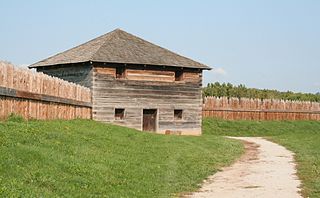
The siege of Fort Meigs took place in late April to early May 1813 during the War of 1812 in northwestern Ohio, present-day Perrysburg. A small British Army unit with support from Indians attempted to capture the recently constructed fort to forestall an American offensive against Detroit, and its Fort Detroit in the Great Lakes region which the British from the north in Canada had captured the previous year. An American sortie and relief attempt failed with heavy casualties, but the British failed to capture the fort and were forced to raise the siege.
The history of Wisconsin encompasses the story not only of the people who have lived in Wisconsin since it became a state of the U.S., but also that of the Native American tribes who made their homeland in Wisconsin, the French and British colonists who were the first Europeans to live there, and the American settlers who lived in Wisconsin when it was a territory.

The Bad Axe Massacre was a massacre of Sauk (Sac) and Meskwaki (Fox) Native Americans by United States Army regulars and militia that occurred on August 1–2, 1832. This final scene of the Black Hawk War took place near present-day Victory, Wisconsin, in the United States. It marked the end of the war between white settlers and militia in Illinois and Michigan Territory, and the Sauk and Fox tribes under warrior Black Hawk.
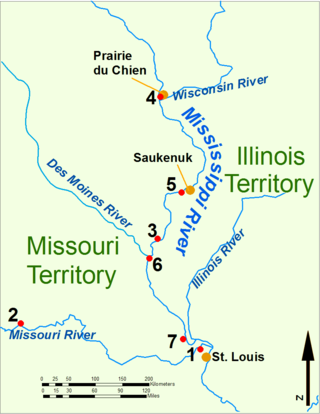
During the War of 1812, the Illinois Territory was the scene of fighting between Native Americans and United States soldiers and settlers. The Illinois Territory at that time included the areas of modern Illinois, Wisconsin and parts of Minnesota and Michigan.

The Winnebago War, also known as the Winnebago Uprising, was a brief conflict that took place in 1827 in the Upper Mississippi River region of the United States, primarily in what is now the state of Wisconsin. Not quite a war, the hostilities were limited to a few attacks on American civilians by a portion of the Winnebago Native American tribe. The Ho-Chunks were reacting to a wave of lead miners trespassing on their lands, and to false rumors that the United States had sent two Ho-Chunk prisoners to a rival tribe for execution.

The Battle of Mackinac Island was a British victory in the War of 1812. Before the war, Fort Mackinac had been an important American trading post in the straits between Lake Michigan and Lake Huron. It was important for its influence and control over the Native American tribes in the area, which was sometimes referred to in historical documents as "Michilimackinac".
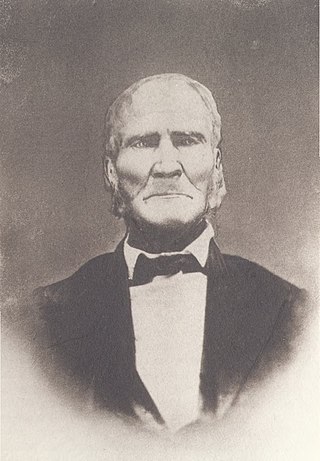
Samuel Whiteside was an Illinois pioneer. A farmer and backwoodsman, Whiteside briefly served in the Illinois General Assembly after statehood and led the Illinois militia for decades, rising to the rank of general but also enlisting as an ordinary soldier when militia calls declined at the end of wars. Whiteside fought the British in the War of 1812 and Native Americans through the Blackhawk War.

The Villa Louis is a National Historic Landmark located on St. Feriole Island, in Prairie du Chien, southwestern Wisconsin. The villa and estate are a historical museum operated by the Wisconsin Historical Society. The site has been restored to its appearance during the late 19th century, when it was the estate of the prominent H. Louis Dousman family, descendants of a fur trader and entrepreneur.
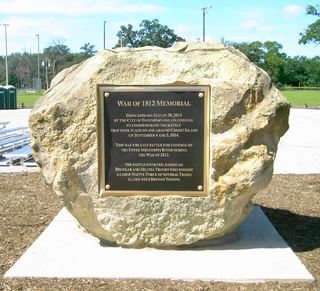
Credit Island is an island in the Mississippi River on the south west side of Davenport, Iowa within the Quad Cities area. Its name was derived by the use of the island as an early Indian trading post. Credit could be obtained on the promise of hides and skins to be delivered at a later time, hence the name. It was listed on the Davenport Register of Historic Properties on February 3, 1999.
Michel Brisbois was a French-Canadian voyageur who was active in the upper Mississippi River valley as early as 1781. Originally a fur trader for the Hudson's Bay Company, he eventually settled in Prairie du Chien, in what became Wisconsin. He had two families, including three children with a Ho-Chunk woman of mixed-race ancestry.

Campbell's Island is an island and unincorporated community in the Mississippi River. The island is located in Hampton Township, Rock Island County, Illinois. It is adjacent to the city of East Moline and is connected to the city by a bridge. It is the site of the Campbell's Island State Memorial, a listed historic site overseen by the Illinois Historic Preservation Agency.

Warrior was a privately owned and constructed steamboat that was pressed into service by the U.S. government during the Black Hawk War to assist with military operations. Warrior was constructed and launched in 1832 at Pittsburgh, Pennsylvania by Joseph Throckmorton who also served as the vessel's captain. Once constructed the vessel traveled to St. Louis and into the war zone. Warrior played a key role in the decisive Battle of Bad Axe. Following the war the steamboat continued its service under Throckmorton along the Upper Mississippi River.

Fort Shelby was a United States military installation in Prairie du Chien. Illinois Territory, built in 1814. It was named for Isaac Shelby, Revolutionary War soldier and first governor of Kentucky. The fort was captured by the British during the Siege of Prairie du Chien in July 1814. The British renamed the fort Fort McKay after Major William McKay, the commander of the forces that won the battle. Fort McKay remained under British control until 1815, when the British destroyed it before leaving the area. Fort Crawford was built on the same site in 1816.
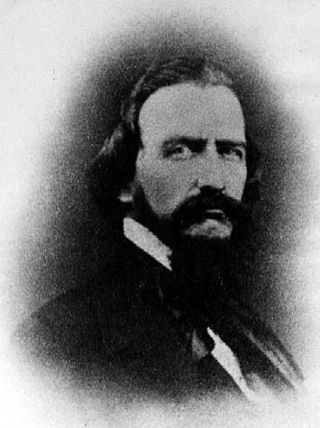
Nicholas Boilvin was a 19th-century American frontiersman, fur trader, and U.S. Indian Agent. He was the first appointed agent to the Winnebagos, as well as the Sauk and Fox, and one of the earliest pioneers to settle in present-day Prairie du Chien, Wisconsin. His sons Nicholas Boilvin, Jr. and William C. Boilvin both became successful businessmen in Wisconsin during the mid- to late 19th century.

Wabasha II, also known as Wapahasha, Wapasha, or "The Leaf," succeeded his father as head chief of the Mdewakanton Dakota tribe in the early 1800s. He led the Dakota forces fighting with the British in the War of 1812, but sided with the United States in the Black Hawk War of 1832. Chief Wabasha II signed the Treaties of Prairie du Chien in 1825 and 1830.

The Battle of Rock Island Rapids, also called the Battle of Campbell Island, was an American defeat during the War of 1812 at the hands of the British allied Sauk, Fox, and Kickapoo. In July 1814, a military expedition was mounted to supply the U.S. garrison at Prairie du Chien after calls for help. The U.S. expedition was ambushed on July 19. In the aftermath another expedition was sent to re-capture Prairie after it fell to the British. This expedition was also ambushed in the Battle of Credit Island and forced to retreat southwards.
The Western theater of the War of 1812 was an theater of war during the War of 1812 between the United States and the United Kingdom. Far from the Atlantic Coast and large cities, logistics and communication were more challenging in the western territories and the United States frontier. For many Native American nations involved, this war was a continuation of the defense of their lands against encroaching settlers.













